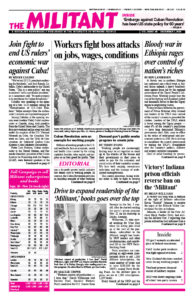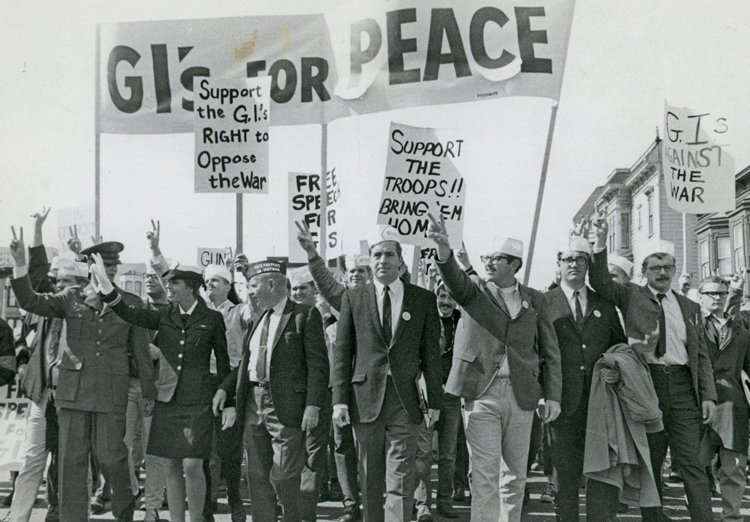Out Now by Fred Halstead is one of Pathfinder’s Books of the Month for November. Halstead, an active participant in and leader of the international movement against the U.S. war in Vietnam, visited and talked with GIs at a U.S. military base in near Saigon as the Socialist Workers Party presidential candidate in 1968. The Vietnam War was the first time U.S. imperialism went down to defeat, thanks to the determination of the peoples of Indochina, the growing opposition of U.S. troops to the war and the solidarity and anti-war protests by tens of millions around the world. The excerpt is from chapter 23, “The Crumbling of U.S. Military Morale.” Copyright © 1991 by Pathfinder Press. Reprinted by permission.
Until 1968, most American GIs in Vietnam still rationalized that the war had some good purpose. But when they returned to the U.S. after the regular one-year tour of duty, they inclined to turn against the war, in part because they could now think about it without the psychological trauma of admitting they were facing death for no good reason, and in part because by 1968 the antiwar sentiment had penetrated deeply among the American youth population.
After the spring of 1968, the rank-and-file replacements to Vietnam tended to be antiwar, or at least very doubtful before they went over, and their experience on the scene tended to reinforce this attitude. While the U.S. troop level did not exceed 550,000 in South Vietnam, because of the one-year tour of duty some 3 million American military personnel served there in the course of the Second Indochina War. From 1968 on, this constant coming and going reinforced the antiwar sentiment among Americans both in Vietnam and at home, and by 1971 it reached a critical point in Vietnam itself.
This crucial interrelationship between the antiwar movement in the U.S. and the antiwar sentiment in the army in Vietnam was expressed in a letter sent to President Nixon in early 1971 by forty young army officers, mostly infantry, en route to Vietnam. Of civilian antiwar activists it said:
Many of these “troublemakers” at home are our younger brothers, or our friends, our girl friends, our wives. We share many of their views.
Now we are asked to lead men who are unconvinced into a war in which few of us believe ourselves. This leaves us with only survival — “kill or be killed” — as a motive for our mission. If the war continues much longer, young Americans may simply refuse to co-operate. You must have us out of Vietnam by then. …
The American operation in Vietnam was always top-heavy, with only about 10 percent of the men sent out on combat missions on any particular day. The great bulk of the remainder were rear-echelon troops, manning bases, handling supplies, maintaining aircraft and other machinery, and so on. To be stationed at some big base in Vietnam, like Cam Ranh Bay, was not much different from being on duty at a comparable base at home, except that boredom, frustration, drug addiction, and the atmosphere of colonialist corruption saturated the place. …
For the ordinary combat soldier (“grunts,” as they were known) it was another story. The draft supplied only a small part of the U.S. military personnel around the world. In combat infantry units in Vietnam, especially after 1968, the ratio of draftees was far higher, sometimes 90 percent, and heavily weighted toward the poor, the Black, and other oppressed nationalities. …
It was the habit of the American command to count progress in terms of “body count,” supposedly the number of NLF and NVA soldiers killed. These statistics were notoriously exaggerated, sometimes including simple falsifications on paper as commanders sought to make themselves look “good.” On many operations there was little if any distinction drawn between combatants and the civilian population in “VC territory.” These areas were frequently designated “free fire zones.” …
But the moral disintegration … was only one side of the story. I know of an artillery spotter who made his choice when a commander radioed him to place a barrage on a village where he could see many civilians, including children. After he reported this situation, the order was reiterated. He directed the strike to an empty area and reported a heavy “kill.” From then on he misdirected fire as a matter of course, except when the lives of GIs were at stake. Solidarity with his buddies was still the cardinal rule, and if it hadn’t been, he wouldn’t have lasted very long.
It was a common occurrence for a patrol out of sight of the command to fire their weapons in the air, then report “kills” where there had been no action at all. For all these reasons, the American ground-combat force in Vietnam had become a net liability by 1971, and this reality, above all, forced Nixon to continue the withdrawals in spite of the failure of “Vietnamization.”
Col. Robert D. Heinl, Jr., (Ret.), a marine corps historian, was one of the many American military experts who considered the force the U.S. had in Vietnam in 1967 to have been the best American army ever put into the field. Yet, in the June 7, 1971, Armed Forces Journal, he made the following astounding statements:
The morale, discipline and battle-worthiness of the U.S. Armed Forces are, with a few salient exceptions, lower and worse than at any time in this century and possibly in the history of the United States.
By every conceivable indicator, our Army that now remains in Vietnam is in a state approaching collapse, with individual units avoiding or having refused combat, murdering their officers and non-commissioned officers, drug-ridden, and dispirited where not near mutinous.
Elsewhere than Vietnam the situation is nearly as serious.
The author cited some evidence to substantiate his conclusions and then continued:
All the foregoing facts — and many more dire indicators of the worst kind of military trouble — point to widespread conditions among American Forces in Vietnam that have only been exceeded in this century by the French Army’s Nivelle Mutinies of 1917 and the collapse of the Tsarist armies in 1916 and 1917.


